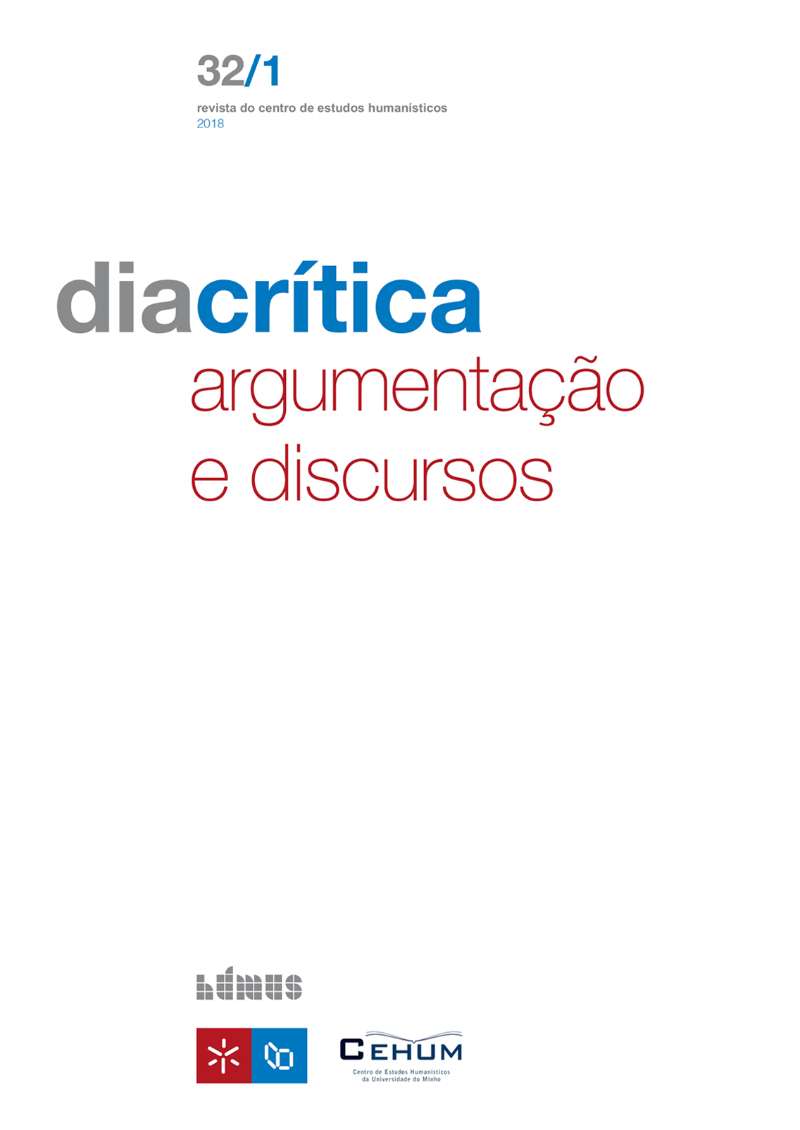From "Lepra" to "Hanseníase": a sociohistorical-based lexicological analysis
DOI:
https://doi.org/10.21814/diacritica.5025Keywords:
lexicon, society, socio-historical lexicology, leprosy, Hansen's diseaseAbstract
This paper investigates the competition between the wordslepra (leprosy) andhanseníase (Hansen’s disease) in Brazilian Portuguese in the 1970s and 2000s. Our research had four steps: (1) gathering lepra and hanseníase tokens from the Jornal do Brasil digital database; (2) observing the emergency, the diffusion, and the frequency of usage of the neologism (hanseníase); (3) selecting two synchronies – the first one before (1970) and the other one after (2000) the token frequency inversion; (4) analysing the words occurrence in 100 texts for each synchrony. According to the analysed data the word hanseníase was first registered in the database in 1970 – during the sanitary reform. In2000 – when the tendency to assess was the cure for the disease – the word hanseníase was more frequent than lepra in the corpus. The results indicate a change of perception of the disease in Brazil. The word hanseníase was created in a period of fight against endemic diseases. With the chance of a cure for the disease, the neologism got stronger and became part of the Brazilian Portuguese lexicon. With the results it was intended to show that the study of the lexicon must consider linguistic and social factors, as it is suggested by the Socio-historical Lexicology.
References
Abbyy Fine Reader (1995). [S.l.]: version 14. Software.
Alves, I. M. (2007). Neologismo. Criação lexical 3. São Paulo: Ática.
Anthony, L. (2011). AntConc (Windows, Macintosh OS X, and Linux): Build 3.2.4. Disponível em: <http://www.antlab.sci.waseda.ac.jp/software/README_AntConc3.2.4.pdf>.
Acessado em: 12 jul. 2017.
Biderman, M. T. (1996). Léxico e vocabulário fundamental.
Alfa, 40, 27-46. Disponível em: <https://periodicos.fclar.unesp.br/alfa/article/view/3994/3664>. Acessado em
abr. 2018.
Biderman, M. T. (1998). Dimensões da palavra. Filologia e Linguística Portuguesa, 2, 81-118. Disponível em: <http://dlcv.fflch.usp.br/sites/dlcv.fflch.usp.br/files/Biderman1998_0. DOI: https://doi.org/10.11606/issn.2176-9419.v0i2p81-118
pdf>. Acessado em 12 jul. 2017.
Bluteau, R. (1728). Vocabulario portuguez & latino: aulico, anatomico, architectonico ... Coimbra: Collegio das Artes da Companhia de Jesu. 8 v. Disponível em: <http://dicionarios.bbm.usp.br/pt-br/dicionario/edicao/1>. Acessado em: 12 jul. 2017.
Braga, J. C. S. & Paula, S. G. (1986). Saúde e previdência, estudos de política social. São Paulo: Hucitec.
Cambraia, C. N. (2013). Da lexicologia social a uma lexicologia sócio-histórica: caminhos possíveis. Revista Estudos Linguísticos, 21(1), 157-188. Disponível em: <http://dx.doi.org/10.17851/2237-2083.21.1.157-188>. Acessado em 12 jul. 2017. DOI: https://doi.org/10.17851/2237-2083.21.1.157-188
Cambraia, C. N. (2015a). Antineologismo. Revista Estudos de Cultura, 3, 65-74. Disponível em: <https://seer.ufs.br/index.php/revec/article/view/4775>. DOI: https://doi.org/10.32748/revec.v0i03.4775
Acessado em 12 jul. 2017.
Cambraia, C. N. (2015b). Lexicologia e informação: um ensaio de quantificação. Entretextos, 15(2), 31-52. Disponível em: DOI: https://doi.org/10.5433/1519-5392.2015v15n2p31
<http://dx.doi.org/10.5433/1519-5392.2015v15n2p31>. Acessado em 12 jul. 2017.
Cançado, M. (2015). Manual de semântica: noções básicas e exercícios. Belo Horizonte: Editora da UFMG.
Carvalho, K. A. (2015). Discussões em torno da reconstrução do significado da lepra no período pós-sulfônico, Minas Gerais, na década de 1950. Hist. cienc. saúde-Manguinhos, 22(2), 541-558. Disponível em: <http://www.scielo.br/pdf/hcsm/v22n2/0104-5970-hcsm-2014005000026.pdf>. Acessado em 12 jul. 2017. DOI: https://doi.org/10.1590/S0104-59702014005000026
Cordeiro, J. M. (2009). Anos de chumbo ou anos de ouro? A memória social sobre o governo Médici. Estudos Históricos, 22, 85-104. Disponível em: DOI: https://doi.org/10.1590/S0103-21862009000100005
<http://dx.doi.org/10.1590/S0103-21862009000100005>. Acessado em 12 jul. 2017.
Coseriu, E. (1967). Das Phänomen der Sprache und das Daseinsverständnis des heutigen Menschen. Die Pädagogische Provinz, n. 1-2, 11-28. Disponível em: <http://www.romling.uni-tuebingen.de/coseriu/publi/coseriu38.pdf>. Acessado em: 12 jul. 2017.
Costa, M. A. (2012). Estruturalismo. In M. E. Martelotta (Org.), Manual de Linguística (pp. 113-126). São Paulo: Contexto.
Contente, M. & Lino, M. T. R. (2017). A neologia - reflexão sobre a variação e a instabilidade conceptual. Atas do V Simpósio Mundial de Estudos de Língua Portuguesa (pp. 701-709). Disponível em: <http://sibaese.unisalento.it/index.php/dvaf/article/view/17819>. Acessado em: 27 abr. 2018.
Faraco, C. A. (2005). Linguística histórica: uma introdução ao estudo da história das línguas. São Paulo: Parábola Editorial.
Geckeler, H. (1976). Semántica estructural y teoría del campo léxico. Madrid: Gredos. Geraerts, D. (2010). Theories of lexical semantics. Oxford; New York: Oxford University Press.
Gordon, W. T. (1982). A history of semantics. Amsterdam/Philadelphia: John Benjamins.
Iordan, I. (1973). Introdução à linguística románica. Lisboa: Calouste Gulbekian.
Matoré, G. (1953). La méthode en lexicologie: domaine français (2ª ed. ampl.). Paris: Didier.
Moreira, T. M. A. et al. (2002). Hanseníase na atenção básica de saúde: efetividade dos treinamentos para os profissionais de saúde no Estado do Rio de Janeiro. Hansen. Int., 27(2), 70-76. Disponível em: <http://www.ilsl.br/revista/detalhe_artigo.php?id=10633>. Acessado em: 12 jul. 2017.
Paiva, C. H. A. & Teixeira, L. A. (2014). Reforma sanitária e a criação do Sistema Único de Saúde: notas sobre contextos e autores. História, Ciências, Saúde – Manguinhos, 21(1), 15-35. Disponível em: <http://dx.doi.org/10.1590/S0104-59702014000100002>. Acessado em 12 jul. 2017. DOI: https://doi.org/10.1590/S0104-59702014000100002
Pottier, B., Audubert, A., Pais, C. T. (1972).Estruturas linguísticas do português. São Paulo: Difusão Europeia do Livro.
Rezende, R. M. & Paula, M. H. (2016). Lematização no ‘Glosário regional’ da obra Estudos de dialetologia portuguesa: linguagem de Goiás – 1944. In A. F. Neves, M. H . Paula, P. H. R. Anjos, J. L Bernardo & M. G. G. Pires (Orgs), Estudos Interdisciplinares em Humanidades e Letras (pp. 495-509). São Paulo: Blucher. DOI: https://doi.org/10.5151/9788580391664-25
Robin, R. (1977). História e linguística. São Paulo: Cultrix.
Santos, V. S. (2003). Pesquisa documental sobre a história da hanseníase no Brasil. Hist. cienc. saúde-Manguinhos, 10(1), 414-426. Disponível em: DOI: https://doi.org/10.1590/S0104-59702003000400019
<http://dx.doi.org/10.1590/S0104-59702003000400019>. Acessado em 12 jul. 2017. Spencer, N. C. W. (1961). Linguistic fields, conceptual systems and the Weldbild. Transactions of the Philological Society, 60(1), 87-106. Disponível em: DOI: https://doi.org/10.1111/j.1467-968X.1961.tb00988.x
<https://doi.org/10.1111/j.1467-968X.1961.tb00988.x>. Acessado em 12 jul. 2017.
Downloads
Published
How to Cite
Issue
Section
License
Copyright (c) 2023 Marcus Dores, Cecília Toledo

This work is licensed under a Creative Commons Attribution-NonCommercial 4.0 International License.










